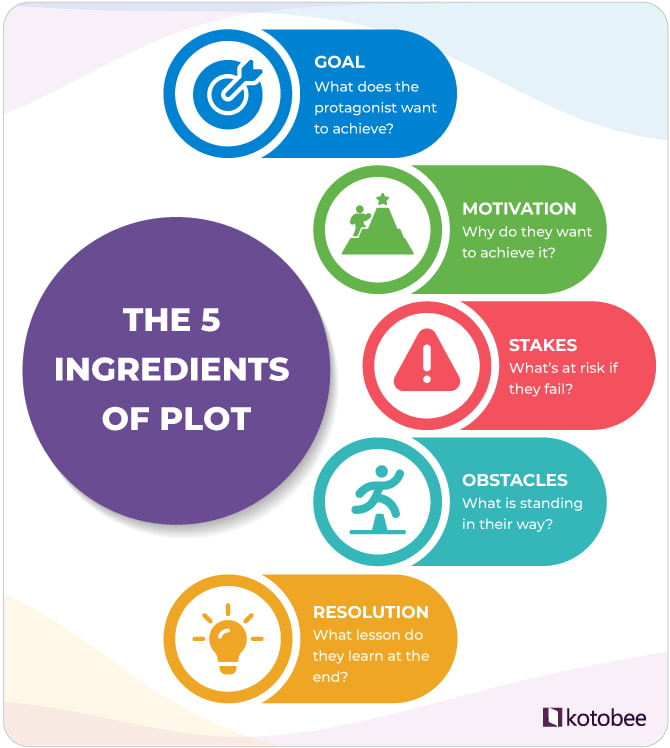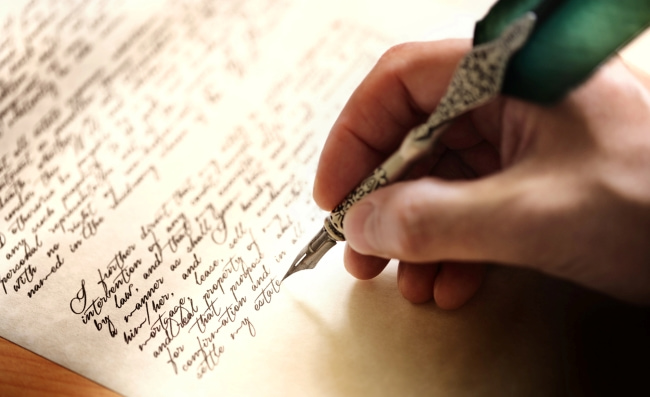Every great story has a plot, whether it is about fulfilling the simplest desires or achieving the most complex ambitions. This element of storytelling is essential to ensuring that readers keep flipping the pages of your book. But if you ask around, you’ll find that many authors struggle with writing a compelling plot. Why is that?
It turns out that learning how to plot a novel is not as straightforward as it sounds. There are many factors that go into the process, such as your genre and story structure. Moreover, plotting a book can be difficult for discovery writers, who prefer to develop their stories as they go.
Fortunately, you can find lots of advice on plotting a book wherever you look. In this very article, we’ve striven to make the process as simple and easy to understand as possible. So if you want to learn the essentials of novel planning, you’re in the right place.

Photo from Depositphotos
Plotting vs Outlining: Are They the Same?
You might have seen other authors use the words “plotting” and “outlining” interchangeably. But did you know that there is a subtle difference between the two? Let’s define each term first so we have a better idea of what they mean:
- Plotting: Plotting is the process of crafting the main events of your story. This includes defining your main character’s goals, their motivations, and the obstacles they face.
- Outlining: An outline combines the plot along with the setting, character arcs, and themes of the story. It acts as the blueprint upon which you will build the whole story.
Now, let’s compare the two to understand the differences between them:
| Plotting | Outlining | |
| Components | All the events that happen in the story | All the events, character arcs, and settings of the story |
| Purpose | To get a general idea of where the story is going | To create a detailed blueprint for the whole story |
| When to Do It | Right after creating your main characters | After deciding on your characters, plot, character arcs, and story themes |
Important Read: How to Write a Compelling Story Outline: A Step-by-Step Guide
What Are the Fundamental Ingredients of a Plot?
No plot is complete without a cast of characters and the events they are living through. However, that definition is not specific enough to help you craft a plot from scratch. To do that, you need to determine why these events are happening in the first place. This can easily be done by identifying the main components of the plot, which are closely connected to one another.
A plot can be broken down into five basic elements:
- Character goal: What does your character want at the beginning of the story? For example, do they want to find a family member who went missing? Or do they want to marry their best friend? Be as specific as possible.
- Motivation: With the main goal established, we now need to set up the motivation, or the “why” behind it. These motivations are what your readers will connect with and what will make them cheer on your main character. As an example, your character Jasper might want to marry their best friend Rory because they want to enter a couples-only competition. More specifically, Jasper wants to win the grand prize: a free vacation that can help him escape the authorities.
- Stakes: Stakes and character motivation are two sides of the same coin. While motivation refers to why a character takes action, stakes refer to what might happen if they don’t act or make the wrong choice. In other words, the stakes are what get readers invested in the plot of the story. In our example, the stakes can be the possibility of Jasper getting caught by the authorities because he committed a serious crime.
- Obstacles in the character’s path: Now, we want to create a few obstacles for our characters to overcome to be able to reach their goals. By doing this, you can challenge them to grow and learn from their mistakes as the story progresses. Going off the previous example, perhaps the obstacle is one of the rules for entering the competition: each couple has to have gotten married six months before signing up. To be eligible for the prize, Jasper forges a fake marriage certificate.
- The results of the characters’ actions: Known as the resolution (or tragedy) of a story, this final element of the plot showcases the aftermath of the main conflict. Here, the main characters tend to learn important lessons that transform their outlook on life, whether or not they win against the antagonist. To illustrate this point, we’ll return to our example from before. Jasper fails to authenticate his fake marriage papers, and he’s sent to prison. However, he’s come to cherish Rory more than before, and the whole ordeal strengthens their bond. Perhaps, Jasper might even marry Rory when he’s done his time!

The 3 Layers of a Plot in a Story
A good plot consists of several layers that are woven together to create a captivating tale. Each layer takes up certain portions of your story, whether it’s just one chapter or several novels in a series. More importantly, adding these different dimensions to your story can make it much more interesting.
Here is a brief explanation of each layer of the plot as well as its importance:
1. Main Plot
Every story needs a major source of conflict, and that’s the main plot. This is the engine that drives the story forward and contains the most significant events. Because of this, the main plot will take up most, if not all, of your story and can even span several books if it’s a series. An example of a main plot is Harry Potter’s feud with Lord Voldemort, which spans all eight books of the Harry Potter franchise.
2. Subplot
While the events of the main plot are progressing, there might be additional conflict that demands the characters’ attention. This new layer is called a subplot, and the focus is usually on characters, settings, or events other than the main ones. As the main plot progresses, the subplot also occurs and connects to it at certain points.
In Harry Potter and the Prisoner of Azkaban, for instance, Hermione’s demanding school schedule, where she attends multiple classes at once using a Time-Turner, creates a subplot. This subplot adds tension and conflict to the story as Hermione becomes increasingly stressed and exhausted, leading to issues and misunderstandings between her and her friends.
3. Side Plot
Finally, side plots are small, self-contained stories that might involve the main characters or center around secondary ones. These tend to be short—no longer than a quarter of your story—and have little to no impact on the main events. However, they can be used to diffuse tension or create a certain mood within the story. They can also be used to provide further development for certain characters or deeper insight into the fictional world of the story.
One of the side plots of Harry Potter and the Order of the Phoenix is Hagrid’s Tale, in which he talks about his journey to the Land of the Giants with the half-giantess, Lady Maxime. This journey is not essential to the main plot of the book, but it offers additional insight into Hagrid’s character and expands the world beyond the main conflict.

4 Popular Plot Structures Used by Authors
Before you start writing a plot for a story, you should choose a structure to follow. These structures can help you focus on the crucial components of the plot and give you a bird’s eye view of the events.
In this section, we’ll go over a few plot structures that many authors like to use.
1. The Classic Plot Structure
The Classic structure serves as the general framework upon which most other plot templates are built. It’s the foundation of most, if not all plot structures out there today. Plus, you can customize it to fit your vision for the story.
As a rule, the Classic plot structure is split into five parts:
- Exposition: This part of your plot is the starting point where you showcase what the world of the story initially looks like. Here, you can also establish your character’s initial goals as well as the stakes.
- Inciting incident: To move the plot forward, you need an inciting incident. This event forces some kind of change in the protagonist’s regular life and causes them to make an important decision.
- Rising action: In this portion of your story, your main characters are trying to accomplish their goals but achieve mixed results. They start to experience a sequence of successes and failures that build up to a final confrontation with the antagonist. The rising action ends with your characters reaching a point of no return, from which they must move forward to achieve their goal.
- Climax: In the climax of your story, the main character gets one more chance to achieve their primary objective. The odds are stacked against them, but they somehow manage to succeed and finally get what they need. However, if you’re writing a tragedy or an unhappy ending, the protagonist may fail—yet still learn a valuable lesson.
- Resolution: This is the final portion of your story, which wraps up most of the remaining loose ends. You can always leave a small mystery or two unsolved as long as you wrap up the main conflict. Some people might expand the resolution to include an epilogue, but that’s completely optional.

Photo from Freepik
2. Three-Act Structure
This plot template takes the classic one and splits it into three acts. The first one starts with setting up the world, your character’s motivations, and the stakes. The second act builds tension, where the protagonist works towards achieving their goal. It usually ends at the character’s lowest point in the story. Finally, the third act starts with the protagonist escaping the crisis. Then the climax occurs, and the story ends with a resolution.
3. 7-Point Story Structure
This relatively new plot structure centers around 7 main points in the story. This structure works well for authors who prefer to plan their books in a non-traditional way, such as starting from the end and working backward. Let’s explore each of the 7 points in more detail:
- Hook: This is where you introduce readers to the world your characters live in.
- First plot turn: The first plot turn is otherwise known as the inciting incident, which kicks the plot into motion.
- First pinch point: As your characters set out to achieve their goal, a new challenge is introduced, which raises the stakes.
- Midpoint: At this point, the character is done simply reacting to events and decides to take matters into their own hands.
- Second pinch point: This point acts as the worst period of time for your characters, where they suffer some major loss.
- Second plot turn: Just as all hope is lost, the second plot turn occurs, and the characters can finally defeat the obstacles in their path.
- Resolution: The resolution marks the end of the conflict and the moment where the characters achieve their goal at long last.
4. Fichtean Curve
This simplified story structure is made up of three parts: the rising action, the climax, and the falling action. The rising action is divided into crises, starting with the inciting incident that kicks off the story. Following that first event, you introduce as many crises as your plot needs before arriving at the climax, which is the height of the conflict. Once the protagonist defeats the antagonist or tragically loses, they reflect on their journey in the falling action.
The Fichtean Curve is a great structure to use for mystery, thriller, horror, and other fast-paced or action-packed genres.
How to Plot a Novel (Tips & Advice)
After choosing your preferred structuring method, it’s time to start plotting your book. We’ve compiled a list of actionable advice that can help you avoid common plotting mistakes. Let’s go over each of them now.
1. Determine Your Genre and Research Common Tropes
While there aren’t any rules set in stone, some genres tend to have common tropes or concepts, which can be found in many of their books. So, a good way to identify them is to read as many stories in your chosen genre as you can. From there, you can understand what readers want to read, which can help you craft a more captivating plot.
However, keep in mind that you should only use these tropes as guides, not rules. After all, you still want your book to be original and explore themes that are unique to your story.

Photo from Freepik
2. Choose the POV of Your Story
Try to think about the point of view of your story before you start writing it. Depending on which one you choose, you might provide readers with a slightly different reading experience.
There are three main perspectives you can write from:
- The first person (I, we): This point of view focuses on one character’s thoughts and feelings at a time. This can lead to readers empathizing and connecting deeply with each of them.
- The second person (you): The second person point of view addresses the reader as if they are experiencing the events first hand, using “you” throughout the narrative. It can create a highly immersive experience, drawing readers into the story as if they are living it. This point of view is far less common because it’s more difficult to execute than the others and may not suit all types of storytelling.
- The third person (he, she, they, it): Finally, the third-person point of view allows you to tell the story from different characters’ perspectives or as an anonymous narrator. This is especially useful in stories that are better told from multiple perspectives. It’s also helpful if you want to place some distance between the readers and the characters.
3. Build the Plot Around Your Characters
While the plot can be exciting and full of drama, readers often get invested in the characters’ journeys rather than the events happening to them. For most stories, it’s best to strike a balance between crafting an eventful plot and focusing on character development. More importantly, you should aim to match the main conflict of the story with your character’s strongest flaws. This means that the crisis hits the characters where it hurts the most, and they can only overcome the conflict by changing that fatal flaw.
Why should you do this? The reason is that your character usually needs to change over the course of the story, and the main catalyst for that change is a strong conflict. So, start the plotting process by understanding your character’s motivations and flaws. Then, shape the plot around their actions and reactions to key events.
4. Plan Out the Main Conflict Before the Rest of the Plot
Once you start plotting your book, it can be easy to get caught up in adding more and more depth to every subplot. Be careful not to fall into this trap, as it can lead to you losing sight of your main plot. To avoid this, start with the main conflict first and then add in your subplots and side plots. As you do so, build up your world slowly, incorporating only the details necessary for each plotline.
If you want to, you can continue world-building once you have an outline for your story. This can help you integrate important details of your world into certain chapters later on. However, try not to focus too much on setting rigid rules for your world, so you have room to get creative.

Photo from Depositphotos
5. Use Your Plot Structure as a Guideline
As you write more stories, you’ll learn over time when to adhere to your chosen plot structure and when to bend the rules. After all, these structures are meant to be used as guidelines rather than strict rulebooks. So don’t stress too much about deviating from a certain structure as you write. More often than not, this happens because you’ve discovered a better way to align the plot with your character arcs.
With that said, if you’re a beginner writer, choose a structure and try to follow it as closely as you can. Mastering the fundamentals of story structure will give you the confidence to experiment effectively later on.
6. Write a Simplified Logline for Your Story
In some cases, you might benefit from summarizing the core premise of your story in a sentence or two. This can also serve as the logline of your book, which is a one-paragraph summary that you might send to agents and publishers later on. More importantly, this summary can keep you focused on the main plot and help you stay on track.
To get started, identify the protagonist’s goal, their motivation, the stakes, and the obstacles in their way. Feel free to use this sentence as a template and customize it to your liking:
[CHARACTER] wants to [GOAL] because [MOTIVATION]. Otherwise, [STAKES] will happen. However, [OBSTACLE] is preventing them.
7. Avoid Resolving Conflicts Using Coincidences or Other Cliche Solutions
When wrapping up your conflict, you might find it difficult to come up with a satisfying solution. Sometimes, you might be tempted to introduce a new character or add some magical solution that answers all of the reader’s questions. However, keep in mind that resolving a conflict with common cliches, such as sudden discoveries, can greatly disappoint your readers.
Let’s illustrate this point through a Greek literary term: “deus ex machina.” This phrase refers to a person, object, or event that conveniently saves the main character or resolves the main conflict. As a general rule, you should steer clear from using these coincidences to drive your plot forward. Otherwise, your readers might not be satisfied with the story.
Here is an example of a deus ex machina: your protagonist is on the brink of death, waiting for the villain to strike the final blow. However, suddenly, they find an ancient magical sword that just so happens to be the villain’s only weakness. To fix this, you can foreshadow the existence of the sword or have the villain possess it until the hero manages to steal it from them.
8. Work Out Your Plot Before Outlining the Story
Before you start outlining your story and exploring character arcs, you might want to craft your plot first. This can help you avoid plot holes—issues that arise because of inconsistencies in the story. Moreover, a finished plotline can help you figure out the best sequence of events for the book. In other words, the flow of your story will improve, and readers will thank you for it.

Photo from Depositphotos
An Example of a Basic Plot Using the Classic Structure
Now that you know the essentials of plotting a story, let’s draft a quick example of our own! The story belongs to the sci-fi genre and will mainly revolve around the themes of idealism and corruption. For context, let’s outline the main elements of the world behind this plot:
- The fictional world: In this world, there are two planets within the same star system. Each of them is inhabited by a different intelligent and technologically advanced alien race. Planet Exality houses the Exalitans, while Planet Membritol is home to the Membrites.
- The premise: Adan, a soldier from Planet Exality, wants to end the war between her people and the Membrite race of Planet Membritol. This is because she has grown up in a war-torn land with little to no food to survive. So, she’s come to hold the belief that peace between the two planets would lead to a better life. However, she encounters a certain Membrite named Troy, who threatens to ruin her chances of ending the war. In the process, sour truths about the Exalitans are revealed, which challenge Adan’s peaceful ambitions in the worst way possible.
With that in mind, let’s break down the plot of this story using the Classic structure.
The Exposition
Adan is an ambitious and idealistic Exalitan soldier who wants to end the ongoing war between her race and the Membrites. She’s just finished another battle against a fleet of Membrite soldiers, yet she feels that her victory is hollow, tainted, and meaningless. She reflects on these emotions as well as how the battle could have gone. In the process, she mourns her fallen friends and the family she lost years ago as a child.
She believes that at this rate, future generations will grow up without family, food, or hope.
The Inciting Incident
As Adan records her victory in the battle logs, she notices that one of the other fleets has logged months of consecutive wins without suffering any casualties. She grows curious about this and asks the soldiers about it, but they evade her questions and only add to her suspicions. So, Adan decides to do some independent research.
Soon afterward, Adan uncovers a lead: those soldiers are illegally buying alien weapons of unknown origins. It turns out that one of these weapons is an illegal drug that physically enhances Exalitans to make them invincible but has some highly dangerous side effects. This makes her angry. It’s bad enough that her people have been at war for centuries. But to add insult to injury, people are also profiting off the war without caring about the consequences of doing so.
This discovery shatters her belief that her people are fighting honorably to protect their home. More importantly, Adan is forced to reconsider her own efforts in the war, and if they are enough to achieve peace.
The Rising Action
When Adan traces these weapons to their source, she finds out about a Membrite named Troy. After she’s discovered, Troy goes back on her deal with Adan’s comrades and tries to disappear. Adan pursues Troy’s lead, trying to put a stop to her business and drive her off Planet Exality. She sees Troy as the embodiment of everything wrong with the war: corruption, selfishness, and anarchy. If she can take Troy down, Adan believes she’ll be removing a key obstacle to peace.
At first, Adan succeeds and Troy leaves the planet, but the businesswoman starts reappearing on Exality time and time again. Each time, Troy is discovered in different countries, supplying different weapons or even working as a mercenary for hire. But, Adan is determined to catch her enemy one way or another and keeps hunting her down.
On one of her chases, Adan accidentally shares too much information about her plans with some of her trusted comrades. Unfortunately, they turn out to be spies for the Membrites, and a big fight occurs from which Adan barely escapes. As she nurses her wounds, her hatred for the war intensifies, as does her dislike of Troy in particular for forcing her into these situations. Now, more than ever, she’s angry, desperate, and much more prone to making poor decisions.
The Climax
As she recovers, Adan discovers that Troy is preparing to fight for the Membrite army to avoid suspicion. This news reminds Adan of her mission, and she vows to defeat Troy. This way, she can take her first major step toward ending the war.
Adan engages Troy in a space battle, but a shocking revelation causes Adan’s world to flip upside down. It turns out that in addition to the interplanetary black market, Planet Exality itself is funding the war and profiting from it. Meanwhile, Planet Membritol is trying to propose a peace treaty and gets silenced every time. As a result, many Membrites are forced to take up dishonorable jobs just to survive.
Everything Adan had ever believed was wrong—Troy was just a byproduct of the real problem. The corruption went much deeper, and Adan’s actions may have only helped maintain the illusion of justice. Unable to accept this new information, Adan goes into a blind rage and destroys every spaceship she sees, whether they’re manned by Exalitans or Membrites. By attacking both sides, Adan passes the point of no return—she can never go back to her former life or her planet.
However, Troy helps her calm down and makes her an irresistible offer: Adan can come with Troy and live in hiding to avoid being convicted for her brash actions. When she calms down, Adan realizes that she has doomed herself to execution according to Exalitan law because she targeted her allies. Seeing no other option, she reluctantly accepts Troy’s offer. Now, Adan understands that if she truly wants peace, she’ll have to fight a much more complicated and insidious enemy: her own home. And to make matters worse, she has to do it in secret, not as an honorable soldier.
The Resolution
Adan and Troy escape the battle undetected and arrive at Troy’s hideout on Planet Membritol. While Adan is still shaken and disillusioned, her time with Troy begins to shift her perspective. Slowly, she learns more about the Membrite side of the war—about the peace negotiations that were silenced, the Exalitan misinformation campaigns, and the Membrite citizens who are also suffering because of the war.
Though she’s still in despair, Adan resolves to use her experience as a soldier and her newfound knowledge to expose the truth behind the war. She begins recording a detailed account of everything she’s learned, starting with the illegal weapons trade on Exality.
Her goal is no longer to stop one person or chase a fantasy of immediate peace. Instead, she has to become a voice of rebellion and reveal to her people the real enemy: the Exalitan system that profits from war.
Adan doesn’t know if she’ll succeed, or if she’ll ever go home. But for the first time, her actions are based on truth, not idealism. Because of this, Adan’s exile ironically becomes her first real step toward peace.
Additional Notes
You might have noticed that the resolution of this plot has left many loose ends unanswered. This is usually done if you intend to write a sequel to your book. While the main conflict has been wrapped up, there are still many smaller ones that can take center stage in the second installment of the story.
Of course, you can choose to resolve those smaller conflicts to create a standalone book as well.

Photo from Depositphotos
Final Thoughts
Plotting your story can be a worthwhile task, even if you’re a discovery writer. It can help you determine the direction of your story and avoid plot errors or inconsistencies. And most importantly, it will help you come up with a compelling story that readers can’t put down. So make sure to bookmark this article and start plotting!
Do you have any additional thoughts or advice to share about the plotting process? If so, write them down in the comments below; we’d love to hear them.
.
Read More
What is Conflict in a Story and How to Write One in 8 Steps

